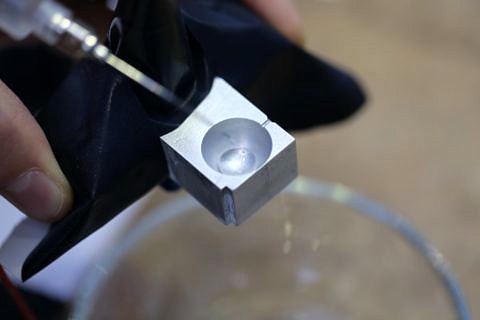The perfect water drop
FAU students visit drop tower in Bremen
FAU students were recently granted access to a unique laboratory, the only one of its kind in Europe, for two weeks by the European Space Agency (ESA). As part of the ‘Drop Your Thesis!’ programme, the FAU team led by team leader Laura Steub and supervised by Jonathan Kollmer used the drop tower at the Center of Applied Space Technology and Microgravity (ZARM) in Bremen to investigate how drops of water are absorbed by different surfaces.
The drop tower is a large laboratory that attracts researchers from all over the world in order to conduct zero-gravity experiments. First the researchers put their experimental set-up into a cylindrical metal capsule. This capsule is then winched up to a height of 120 metres and dropped to the ground inside an evacuated chute. This gives the researchers around five seconds of almost perfect zero-gravity before the capsule hits the ground where it lands softly in a huge container full of polystyrene balls.
A short flight
The flight time of around five seconds per drop was enough time for the FAU team to make their observations. Their first aim was to create and observe a perfectly round drop with a diameter of 1.5 centimetres in zero-gravity. It was this aspect that led the three students to choose their team name, Dropping Drops. The second goal was to allow the drops to come into contact with different surfaces with varying degrees of porosity to see how they were absorbed. The results were recorded by high-speed cameras that capture 32,000 data points per drop.
Important research
The FAU team studied the physical processes that occur as water wets porous surfaces. When carried out right, this process is crucial in applications in which the three states of matter are all present at the same time – such as in fuel cells, heat pipes or filtration systems. The performance of these systems depends to a large extent on liquids such as water being able to overcome gravity and flow into small pores. Experimenting with these forces in zero-gravity helps to better understand this phenomenon.
Trying and testing
It took the team a week to prepare their experiment for the drop tower and they had a few technical difficulties to deal with. Thanks to the support of the staff at ZARM, all of the components were set up correctly by the second week. ‘It was more complicated than we expected, but the technicians at ZARM made it possible for us to make the most of the drop tower in the short time available,’ team leader Laura Steub reports. The team collected a large amount of data. ‘Now we have to analyse what we have observed,’ says project supervisor Jonathan Kollmer, a research associate at the Chair of Multiscale Simulation of Particulate Systems.
Further information:
Jonathan Kollmer
Phone: +49 9131 8520832
jonathan.kollmer@fau.de
